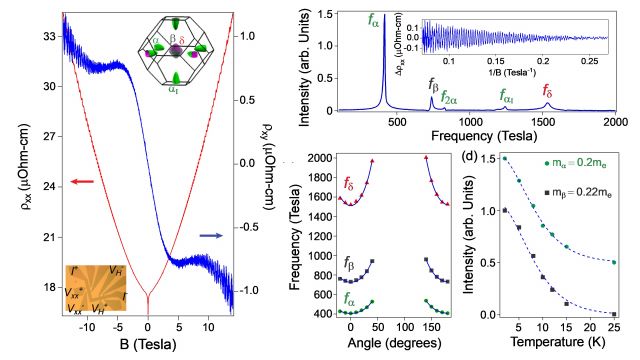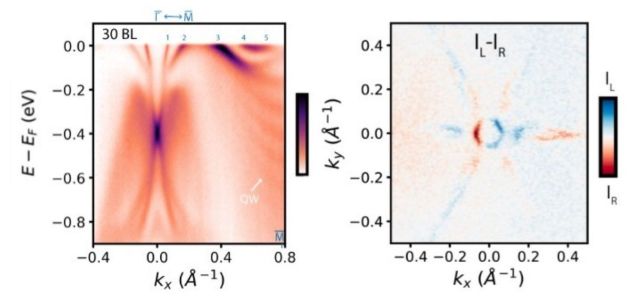Novel Electronic/Topological/Magnetic Properties

Predictions of topological semimetallic states and observations of extremely large magnetoresistance (XMR) in RE-Vs, and specifically GdSb and LuSb, have opened up a new research front aimed at investigating the interplay between magnetic ordering and XMR. We have studied the origin of these properties in LuSb and studied their tunability through dimensional confinement and epitaxial strain.
The discovery of topological phases of matter showed that there is a strong correlation between the physical properties of materials and the topological properties of their band structure. In this context, our group uses state of the art techniques to investigate how topology, dimensionality, strain and chemical composition interact together and modify band structure and physical behavior of materials.
Relevant Publications
Tuning the band topology of GdSb by epitaxial strain
Epitaxial growth, magnetoresistance, and electronic band structure of GdSb magnetic semimetal films
Weak antilocalization in quasi-two-dimensional electronic states of epitaxial LuSb thin films

Topological Material Growth and Characterization
The discovery of topological phases of matter has revealed that there is a strong correlation between the physical properties of materials and the topological properties of their band structure. In this context, our group uses state of the art techniques to investigate how topology, dimensionality, strain and chemical composition interact together and modify band structure and physical behavior of materials.
Relevant Publications
Hybridization gap approaching the two-dimensional limit of topological insulator BixSb1-x
Growth and characterization of 𝛼-Sn thin films on In- and Sb-rich reconstructions of InSb(001)
Inversion Symmetry Breaking in Epitaxial Ultrathin Bi (111) Films
Strain Solitons in an Epitaxially Strained van der Waals-like Material

Epitaxial III-V based nanocomposites
Epitaxial III-V based nanocomposites are comprised of small rare-earth monopnictides (RE-V) nanoparticles embedded in thermoelectric semiconductor alloys during MBE growth. The inclusion of nanoparticles increases the number of interfaces leading to an increase in phonon scattering and a decrease in thermal conductivity. In addition, these particular nanoparticles are believed to provide enhanced electrical conduction through electron filtering mechanisms. RE-V materials are primarily cubic materials with the rock-salt crystal structure and have lattice parameters commensurate with many of the III-V based semiconductors. The RE-V materials are thermodynamically stable with their III-V semiconductor counterparts and the rare-earth elements have low solubilities in the host semiconductors leading to the precipitation of nanoparticles at relatively low concentrations. This supports the growth of single crystal, low dislocation density nanocomposites with coherent interfaces for electron conduction and phonon scattering.
Relevant Publications
Lattice distortion in single crystal rare-earth arsenide/GaAs nanocomposites
Size effects on the electronic structure of ErSb nanoparticles embedded in the GaSb(001) surface